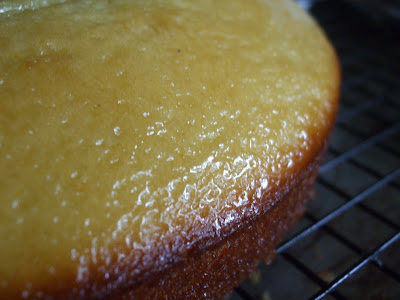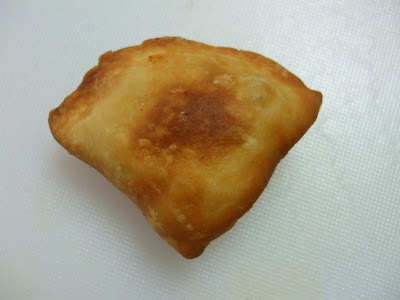I've missed you. Seriously. I've been so busy lately, and I haven't had the time to really cook anything. I'm so sad about that. But, anyway, I finally did it; I made my macarons. I feel like I've just been initiated into a whole new level of... foodiness. It feels awesome.
They don't look fancy, do they? That probably has something to do with the fact that I don't have a round piping tip. I had to just make it round as I piped the mixture on to the parchment. I tried.
I used a recipe I found on Tartelette. The original recipe was for blue chocolate-filled macarons. I didn't have any powdered food coloring, so I made white ones. I made two kinds of macarons--ones filled with bittersweet chocolate, and ones filled with orange curd. I was a little worried about the orange curd because my grandma (yes, she's here now) said that it wasn't sweet enough. But, I thought the meringue would be really sweet--and it is--so, I didn't change it. She thinks I did though. Shh.
French Macarons (from Tartelette)
3 egg whites
50 gr. granulated sugar
200 gr. powdered sugar
110 gr. ground almonds
2 Tb blue powdered food coloring
For the whites: the day before (24hrs), separate your eggs and store the whites at room temperature on a covered container. If you want to use 48hrs (or more) egg whites, you can store them in the fridge.
In a stand mixer fitted with the whisk attachment, whip the egg whites to a foam, gradually add the sugar until you obtain a glossy meringue. Do not overbeat your meringue or it will be too dry and your macarons won't work. Combine the ground almonds and powdered sugar in a food processor and give them a quick pulse. It will break the powdered sugar lumps and combine your almonds with it evenly. Add them to the meringue, give it a quick fold and remove some of the batter that will remain uncolored. Add 2 TB food coloring to the rest and fold the mass carefully until you obtain a batter that flows like magma or a thick ribbon.
Give quick strokes at first to break the mass and slow down. The whole process should not take more than 50 strokes. Test a small amount on a plate: if the tops flattens on its own you are good to go. If there is a small beak, give the batter a couple of turns. Do the same for the plain batter.s
Fill a pastry bag fitted with a plain tip with the batter and pipe small rounds (1.5 inches in diameter) onto parchment paper baking sheets.
With a toothpick dab dots of the plain batter and swirl.
Preheat the oven to 300F. Let the macarons sit out for an hour to harden their shells a bit and bake for 8-10 minutes, depending on their size. Let cool.
If you have trouble removing the shells, pour a couple of drops of water under the parchment paper while the sheet is still a bit warm and the macarons will lift up more easily do to the moisture. Don't let them sit there in it too long or they will become soggy. Pipe or spoon some ganache on one shell and sandwich with another one.
50 gr. granulated sugar
200 gr. powdered sugar
110 gr. ground almonds
2 Tb blue powdered food coloring
For the whites: the day before (24hrs), separate your eggs and store the whites at room temperature on a covered container. If you want to use 48hrs (or more) egg whites, you can store them in the fridge.
In a stand mixer fitted with the whisk attachment, whip the egg whites to a foam, gradually add the sugar until you obtain a glossy meringue. Do not overbeat your meringue or it will be too dry and your macarons won't work. Combine the ground almonds and powdered sugar in a food processor and give them a quick pulse. It will break the powdered sugar lumps and combine your almonds with it evenly. Add them to the meringue, give it a quick fold and remove some of the batter that will remain uncolored. Add 2 TB food coloring to the rest and fold the mass carefully until you obtain a batter that flows like magma or a thick ribbon.
Give quick strokes at first to break the mass and slow down. The whole process should not take more than 50 strokes. Test a small amount on a plate: if the tops flattens on its own you are good to go. If there is a small beak, give the batter a couple of turns. Do the same for the plain batter.s
Fill a pastry bag fitted with a plain tip with the batter and pipe small rounds (1.5 inches in diameter) onto parchment paper baking sheets.
With a toothpick dab dots of the plain batter and swirl.
Preheat the oven to 300F. Let the macarons sit out for an hour to harden their shells a bit and bake for 8-10 minutes, depending on their size. Let cool.
If you have trouble removing the shells, pour a couple of drops of water under the parchment paper while the sheet is still a bit warm and the macarons will lift up more easily do to the moisture. Don't let them sit there in it too long or they will become soggy. Pipe or spoon some ganache on one shell and sandwich with another one.
Chocolate Ganache
3/4 cup heavy cream
1 cup bittersweet chocolate
In a heavy saucepan set over medium heat, bring the heavy cream to a boil. Remove from the stove and add the chocolate to it. Let stand 2 minutes and then stir until fully combined. Let cool until firm enough to put in a small piping bag.
1 cup bittersweet chocolate
In a heavy saucepan set over medium heat, bring the heavy cream to a boil. Remove from the stove and add the chocolate to it. Let stand 2 minutes and then stir until fully combined. Let cool until firm enough to put in a small piping bag.
Don't you just love the gloss on perfectly whipped meringue?
I was really scared about messing up the meringue when I had to fold in the sugar and almond flour mixture. But, I guess it did have to "deflate" a little and become a little liquid for this thing to work.
I did not mess up. Look at the cute little cookies! Look at them! Oh, and don't they have great feet? I was really afraid that they wouldn't come out looking like they did. Please give them that one hour to set before baking. It makes a difference; trust me.
I have to go back to being a student now. I have a quiz over the Thirty Years War tomorrow. Happy baking, everyone.



















































